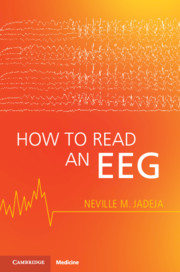Book contents
- How to Read an EEG
- How to Read an EEG
- Copyright page
- Dedication
- Contents
- Figure Contributions
- Foreword
- Preface
- How to Read This Book
- Part I Basics
- Chapter 1 Introduction
- Chapter 2 Polarity
- Chapter 3 Montages
- Chapter 4 Localization
- Chapter 5 Active Reference
- Chapter 6 Frequencies and Rhythms
- Chapter 7 Maturation
- Chapter 8 Normal Adult EEG
- Part II Interpretation
- Part III Specific Conditions
- Appendix How to Write a Report
- Index
- References
Chapter 8 - Normal Adult EEG
from Part I - Basics
Published online by Cambridge University Press: 24 June 2021
- How to Read an EEG
- How to Read an EEG
- Copyright page
- Dedication
- Contents
- Figure Contributions
- Foreword
- Preface
- How to Read This Book
- Part I Basics
- Chapter 1 Introduction
- Chapter 2 Polarity
- Chapter 3 Montages
- Chapter 4 Localization
- Chapter 5 Active Reference
- Chapter 6 Frequencies and Rhythms
- Chapter 7 Maturation
- Chapter 8 Normal Adult EEG
- Part II Interpretation
- Part III Specific Conditions
- Appendix How to Write a Report
- Index
- References
Summary
The normal EEG doesn’t change much during adult life, but it must be interpreted in the context of physiological states (awake, drowsy, or asleep). Normal wakefulness is characterized by a reactive posterior dominant alpha rhythm, anterior faster beta activity, eye blink, and muscle artifact. Transition to drowsiness is typically characterized by attenuation of the posterior dominant rhythm, diffuse slowing into theta range, emergence of slow lateral eye movements, and dissipation of muscle artifact. Vertex waves are the architectural feature of stage I sleep. Positive Occipital Sharp Transients of Sleep (POSTS) may also occur. Sleep spindles and K complexes are the architectural feature of stage II sleep. Mitten waves are a normal variant, while dyshormia is abnormal. Slow wave sleep is characterized by diffuse high-amplitude semi-rhythmic delta slowing. Rapid eye movement sleep is characterized by eye movement artifact and sawtooth waves.
Keywords
Information
- Type
- Chapter
- Information
- How to Read an EEG , pp. 53 - 60Publisher: Cambridge University PressPrint publication year: 2021
